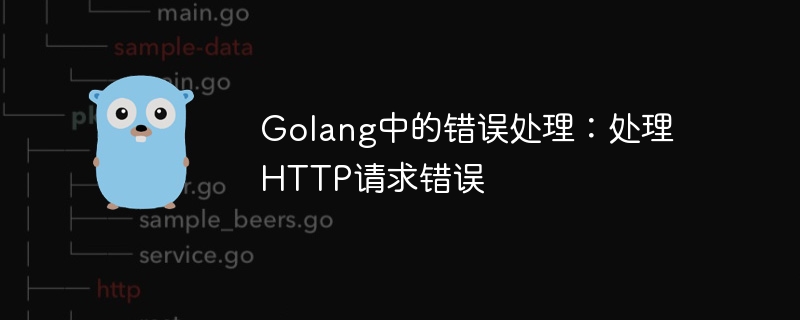

Error handling in Golang: Handling HTTP request errors
Introduction:
Error handling is one of the problems that every programmer must face during the development process one. Especially when processing HTTP requests, error handling is particularly important. Golang provides a powerful error handling mechanism. This article will introduce how to handle HTTP request errors in Golang and illustrate it with code examples.
1. The importance of handling HTTP request errors
In actual application development, it is often necessary to interact with external services. The most common one is to communicate with RESTful API through HTTP requests. However, due to network, server-side, interface definition, etc., various errors may occur in HTTP requests, such as timeout, connection rejection, return status code error, etc. Therefore, we need to properly handle these errors in the code to ensure the stability and reliability of the program.
2. Golang’s error handling mechanism
Golang adopts a simple but powerful error handling mechanism, which uses return values to pass error information. In Golang, a function can return multiple values, and the last return value is usually used to indicate an error. If the function executes normally, the error return value is nil; if the function executes incorrectly, the corresponding error message is returned.
The example is as follows:
func Divide(a, b float64) (float64, error) {
if b == 0 {
return 0, errors.New("Divisor cannot be zero")
}
return a / b, nil
}
func main() {
result, err := Divide(10, 5)
if err != nil {
fmt.Println("Error:", err)
return
}
fmt.Println("Result:", result)
}In the above example, the Divide function is used to calculate the division between two floating point numbers. If the divisor is zero, an error message is returned. In the main function, we can check whether an error occurred by judging whether err is nil. If err is not nil, an error occurs and the corresponding error message is printed; otherwise, the calculation result is printed. This error handling method is concise and easy to understand and implement.
3. Methods of handling HTTP request errors
When handling HTTP request errors, we can learn from the above error handling mechanism. Golang's standard library net/http provides many functions and types for handling HTTP requests. The Do method can be used to send HTTP requests and obtain responses.
We can handle errors that may occur in the request by checking the error returned by the Do method, such as connection failure, timeout, request rejection, etc. The following is an example:
import (
"fmt"
"net/http"
)
func main() {
resp, err := http.Get("https://api.example.com/users")
if err != nil {
fmt.Println("Error:", err)
return
}
defer resp.Body.Close()
// 处理响应
// ...
}In the above example, we sent a GET request through the http.Get method and got a response of type http.Response. We can handle possible errors by checking err. If err is not nil, it means that the request failed to be sent and can be processed according to the actual situation; otherwise, we can continue to process the response.
4. Custom errors
In addition to using the error types in the standard library, we can also customize error types to facilitate and better handle errors. In Golang, a custom error type only needs to implement the Error() method.
The example is as follows:
type MyError struct {
Msg string
}
func (e *MyError) Error() string {
return e.Msg
}
func Divide(a, b float64) (float64, error) {
if b == 0 {
return 0, &MyError{"Divisor cannot be zero"}
}
return a / b, nil
}
func main() {
result, err := Divide(10, 0)
if err != nil {
fmt.Println("Error:", err)
return
}
fmt.Println("Result:", result)
}In the above example, we defined a custom error type MyError and implemented the Error() method. In the Divide function, if the divider is zero, an error of type MyError is returned. In the main function, we can determine whether a custom error has occurred by determining whether err is of type MyError, and obtain the corresponding error information.
Conclusion:
Through the above code examples, we can see that handling HTTP request errors in Golang is very simple and flexible. We can pass error information by returning an error and handle it according to the actual situation. At the same time, we can also customize error types to better handle specific error situations.
In summary, for applications that need to handle HTTP request errors, it is very important to use Golang's error handling mechanism reasonably. It will help improve the stability and reliability of the program, and Provide a better user experience.
The above is the detailed content of Error handling in Golang: Handling HTTP request errors. For more information, please follow other related articles on the PHP Chinese website!
 How to solve 0xc000409 error
How to solve 0xc000409 error
 How to solve the WerFault.exe application error
How to solve the WerFault.exe application error
 How to define variables in golang
How to define variables in golang
 What are the data conversion methods in golang?
What are the data conversion methods in golang?
 What are the commonly used libraries in golang?
What are the commonly used libraries in golang?
 What is the difference between golang and python
What is the difference between golang and python
 Summary of commonly used computer shortcut keys
Summary of commonly used computer shortcut keys
 Where to buy Bitcoin
Where to buy Bitcoin




